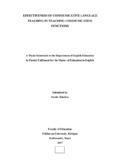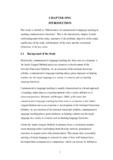Please use this identifier to cite or link to this item:
https://elibrary.tucl.edu.np/handle/123456789/1577| Title: | Effectiveness of Communicative Language Teaching in Teaching Communicative Functions |
| Authors: | Khadka, Sunita |
| Keywords: | Communicative Language;Communicative Functions;Okhaldhunga district;Competence |
| Issue Date: | 2017 |
| Abstract: | The present study entitled Effectiveness of Communicative Language Teaching in Teaching Communicative Functions was an attempt to find out the effectiveness of communicative language teaching in teaching communicative function. In order to carry out this study, I selected thirty-two students of Grade 10 from Shree Chyuridanda secondary school of Okhaldhunga district, using simple random sampling procedure. I used primary and secondary sources of data. To selecting the sample, a pre-test was administered to determine the students’ initial proficiency on communicative functions. The students were divided experimental and controlled by using odd and even ranking procedure. Same tools, materials, medium were used for the both groups. The only variation was the use of approach, i.e. communicative language teaching. After 30 days of teaching, the post-test was administrated. The individual scores taken from both pre-test and post-test were tabulated under different sub-headings. The difference between average score of pre-test and post-test was computed. The major findings of the study is teaching communicative function through communicative language teaching was found to be more effective than conventional teacher centered approaches. The progress was seen in favor of experimental group in almost all the items. This thesis consists of five chapters. The first chapter deals with background of the study, statement of the problem, objectives, research hypotheses, significance of the study, delimitation of the study and operational definition of key terms. The second chapter deals with the review of related literature and conceptual framework that consists of review of theoretical literature, review of empirical literature, implications of the review for the study and conceptual framework. The third chapter deals with methods and procedure of the study that consists of design and method of the study, population, sample and sampling strategies, study area, data collection tools and approaches, and procedure. Similarly, the fourth chapter deals with data analysis and interpretation of results, summary and findings. The final chapter deals with conclusion and pedagogical implications. The final part of the study subsumes references and appendices. |
| URI: | http://elibrary.tucl.edu.np/handle/123456789/1577 |
| Appears in Collections: | English Language Education |
Files in This Item:
| File | Description | Size | Format | |
|---|---|---|---|---|
| sunte 1cover page.pdf | 79.88 kB | Adobe PDF |  View/Open | |
| sunita thesis (1).pdf | 495.03 kB | Adobe PDF |  View/Open |
Items in DSpace are protected by copyright, with all rights reserved, unless otherwise indicated.
